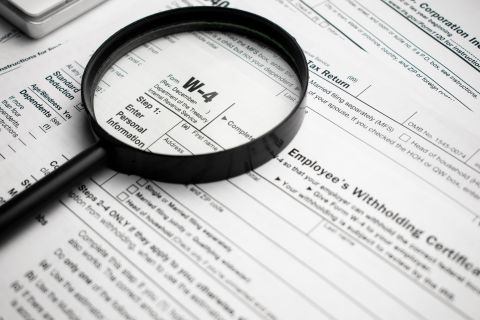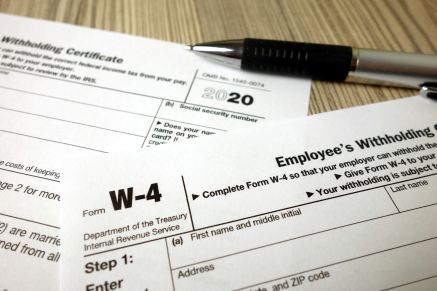
CommonCentsMom.com is advertiser-supported: we may earn compensation from the products and offers mentioned in this article. However, any expressed opinions are our own and aren't influenced by compensation. The contents of the CommonCentsMom.com website, such as text, graphics, images, and other material contained on this site (“Content”) are for informational purposes only. The Content is not intended to be a substitute for professional financial or legal advice. Always seek the advice of your Financial Advisor, CPA and Lawyer with any questions you may have regarding your situation. Never disregard professional advice or delay in seeking it because of something you have read on this website!
Taxpayers prepare returns every year, and it often seems that the process of filing them is somehow less easy or more complex than it was. If your job suddenly changes, and you need an additional W-4 form to report your income, you may ask: Should I claim 1 or 0 on my taxes?
It’s no more pertinent to ask whether you want to claim a certain amount of money on your taxes or not, and we hope this helps! Why? As a result, the Internal Revenue Service has changed the way that taxpayers claim income on the W-4 Form.
What Is a W-4 Tax Form?
It’s important to know what a W-4 tax form is before you can start receiving a larger tax refund or if you want to have less money withdrawn from your paycheck each week. You have to fill out many forms each time you start working for a new employer.
If you are a business owner, a W4 is the document that lets your employer know how much tax to hold on your paychecks.
Should I Claim 1 or 0 on My Taxes?
It is easy to feel stressed when you think about how to decide whether you should claim 1 or 0 on your tax return. No more asking for allowances or exemptions; in fact, no one will even ask if you want to claim any tax benefits at all.
It may be difficult to complete a tax return if you have not done it yet, but no more worrying about the amount of tax allowances you want to claim.
Tax Allowances and Exemptions on a W-4 Form
There have been many changes in how tax refunds are processed as of now. This year, don’t bother trying to figure out how to get certain tax breaks or exemptions.
If you make more money than you used to, you could pay the debts first to avoid paying the interest rates.
Steps for Completion on Form W-4
There is a specific checklist you must take to help you prepare a W-4. Most individuals only have to do steps one and five to receive their W-4 form. Still, depending on your specific needs, you might have further to report.
Step 1: Personal Information
If you are asked to fill out the W-4, you must include some basic information about yourself.
Step 2: Multiple Jobs or Spouse Works
If all you need is one regular monthly income, you do not need to do this step. You may be required to pay tax on a portion or all of your income if any of the following situations apply to you:
- You work on more jobs at a time.
- You and your partner are filing joint taxes, and your partner works.
How much income you earn will determine how much you can keep. You can use this IRS tool to calculate the tax withdrawal amount from your paychecks.
The amount of tax that the taxpayer is required to pay is dependent on the estimated amount that the government has collected, which is what the tax withheld calculator is able to calculate.
Step 3: Claim Dependents
In years past, taxpayers were asked whether they were entitled to any exemptions for themselves or for dependents. But as a result of a new Form W-4, taxpayers will now be asked if they have dependents.
Add $2000 to each child who is considered to be a dependent of the parents by multiplying by two (2).
If you are earning a lot of money and you file your taxes correctly, you may be able to claim the Child Tax Credit.

The Child Tax Credit
Child Tax Credits are tax benefits that can be applied to the income of a taxpayer and his or her family.
Under the new plan, children can claim up to $5,000 annually under the Child Tax Credit. Eligibility increases from $7,500 to $3,000 for every child under 18 years of age or to $3,600 for each child under six years of age.
The tax credit for children who are disabled is now fully refunded.
Qualifying for the Child Tax Credit
It is necessary for the parent to be able to pay income tax on behalf of the child in order that the credit can be granted, and for each child to have certain tax benefits, the parent must pay income tax on behalf of the child in order that their benefits are granted.
Taxpayer Qualification For The Child Tax Credit
Taxpayers may qualify for the Children’s Tax Credit if they claim certain children as dependents. But their household income must be within a certain range specified in their W-4. Single taxpayer income must not exceed $200,000. Married taxpayer income must not exceed $400,000.
Taxpayers who are elderly or have children who are disabled can claim a tax credit for their grandchildren or siblings and children who live with their families in foster care.
To be eligible to receive help from relatives, taxpayers must contribute more than half of their income for a full year. Members of the same family must comply with certain requirements if they are dependent upon each other.
Dependent Qualification For The Child Tax Credit
Children and dependents must meet some requirements in order to receive the Child Tax Credit on their W-4.
Child Tax Credit applicants must be younger than 17 years old. They have been living with a taxpayer who is claiming Child Tax Credit for at least half the tax year. Children must support you in full in order for you to pay taxes in the tax year.
There are three types of status that dependent people must have: U.S. citizen, U.S. national, U.S. resident alien
Step 4: Other Adjustments
Section 4(A)
If a taxpayer has income that is not earned from selling things, he must also list income that is earned by selling things, and the income that is earned by selling things.
Money that is earned through savings or retirement can be deemed to be income that is earned by people who are not working. Failure by some taxpayers to pay the tax due on income they earn through other means could cause a substantial penalty.
Section 4(B)
A taxpayer can decide whether to take a deduction for a taxable year or to have an itemized deduction taken from their pay. Some taxpayers decide to take the default deduction for a larger tax refund. But itemize your deductions to get a higher deduction than the normal deduction.
Step 5: Signing
It is necessary for you to sign and return the completed form to the IRS in order to make a tax return.
When Should I Update My W-4 Withholding?
If you have changes in your finances or experience a life-changing event, you should adjust the amount that you can deduct from your taxes.
Here are some common situations where you might need to adjust your withholding taxes.
- You or your partenrpouse is getting a second occupation
- You are unoccupied half of the year
- If you are getting married or getting divorced
- If you have baby
Conclusion
With new W-2 Forms, taxpayers are no more worried that they want to take advantage of all the allowances that are available to them in order to get more money every paycheck. You need to know how W-4 rules have changed in order to get the money you need when you need it.







